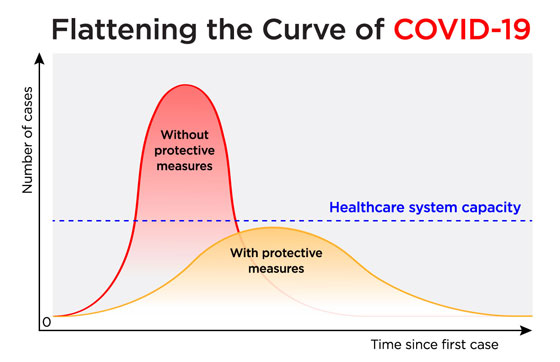Take the mystery out of the curve.

Take the mystery out of the curve
In the media, the expression "flattening the curve" is often accompanied by a graph showing two curves placed side by side: one is comparable to a mountain, high and pointed, and the other resembles a broad hill.
This depiction, widely shared since the start of the coronavirus (SARS-CoV-2) outbreak, represents the number of COVID-19 infections recorded each day as a function of the days that have passed since the very first case.
The difference between the two curves? The absence or presence of public health measures designed to slow the spread of the virus.
The curves are therefore a representation of the evolution of an epidemic with and without preventive actions.

Know how to interpret the results
Here’s how to read these two curves:
- The first curve, sharp and high, illustrates the potential situation in the absence of public health interventions. It shows that more people will be infected with the coronavirus and that the expected peak number of cases (i.e., the peak of the outbreak) will be reached more quickly.
- The second curve, the hill-like one, represents the potential situation with public health intervention. The cases increase at a slower rate, and the peak of the outbreak is lower and occurs later.
Saving time: Why we want to slow the outbreak
What could a sudden and massive "explosion" of SARS-CoV-2 cases cause? It could have a dramatic effect on the already stretched health care system.
In the case of the first curve, at some point, with the number of cases being so high, health services would no longer be able to provide adequate care to infected people. This situation has been experienced in China and Italy, among others, where it has led to a higher number of deaths. This is because in an overburdened health system, many patients do not have access to the medical services and equipment they need.
If we look at the second curve, the threshold of saturation of health services is not exceeded. Health services are able to better prepare and respond to a growing but controlled demand for care. In other words, the system does not collapse under the magnitude of the task.
What public health measures need to be taken to reduce contamination?
There is currently no vaccine or recognized antiviral cure for COVID-19 for the general population. Only so-called "public health" measures are available to reduce contamination.
These are measures that we can take individually. Here are some examples:
- Limit movements to essential tasks only
- Stay at home if over the age of 70
- Practise social distancing (stay a minimum of 2 metres away from others)
- Adopt exemplary hand hygiene: wash your hands before and after preparing a meal, after coughing/sneezing into a handkerchief, after using the toilet, etc.
- Cough and sneeze into the crook of your elbow or into a tissue (make sure to dispose of it in a closed garbage can)
- Avoid bringing your hands to your face
- Clean frequently used surfaces and objects
- Self-isolate if you believe you may have contracted the virus
- if infection is confirmed, follow the recommended isolation guidelines
They also include community actions, such as the following:
- Cancellation of both indoor and outdoor gatherings
- Closure of gathering places (e.g., restaurants, cinemas, theatres)
- Closure of schools and daycares
- Facilitation of telework
Every member of society can contribute to eradicating the current threat. We must put the collective good first. Everyone can act responsibly and conscientiously and adopt safe behaviour.
Together, we can fight COVID-19.
Browse our other articles on the pandemic:
